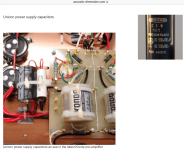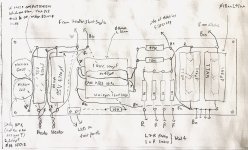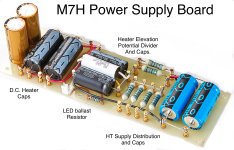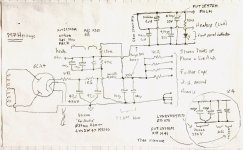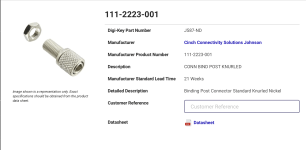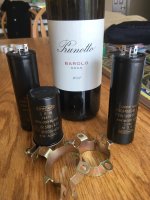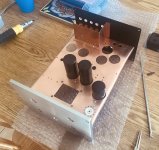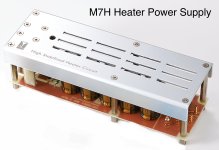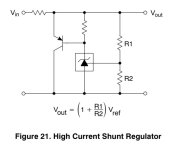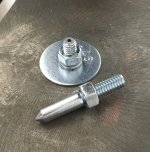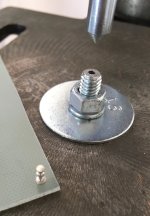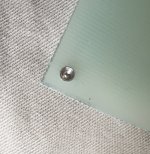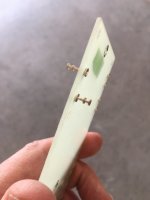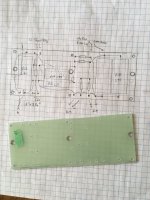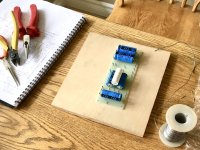Member
Joined 2009
Paid Member
I'm not going to consider the M7H phono section for my inspiration, the original M7 is still my preference.
The Condo unit used some Black Gate caps in the PSU if I interpreted the on-line images correctly. These aren't obtainable any more and most of them are quite old. I've looked closely to see what Audionote are using these days and it's a company called Unicon.
They are rather hard to obtain, but fortunately Hi-Fi Collective (UK) have limited stock of these beasties.
Note: The red circles and lines added to the attached PDF datasheet are my additions, to indicate which caps I will be after.
The Condo unit used some Black Gate caps in the PSU if I interpreted the on-line images correctly. These aren't obtainable any more and most of them are quite old. I've looked closely to see what Audionote are using these days and it's a company called Unicon.
They are rather hard to obtain, but fortunately Hi-Fi Collective (UK) have limited stock of these beasties.
Note: The red circles and lines added to the attached PDF datasheet are my additions, to indicate which caps I will be after.
Attachments
Last edited:
You are certainly right about BlackGates. To my ears the BlackGate WKZ series are still the best sounding power supply caps. I was fortunate to buy a number of them when they were discontinued and I have used them in all my “keeper” projects. For example my phono preamp uses three WKZ 100+100uf 500v caps.
Audio Note UK made a big deal about their Kaisei caps claiming they were almost as good as BG. I wish that were true, but alas they don’t sound anywhere near as good. I haven’t tried the Unicon caps so I don’t know how they stack up.
Audio Note UK made a big deal about their Kaisei caps claiming they were almost as good as BG. I wish that were true, but alas they don’t sound anywhere near as good. I haven’t tried the Unicon caps so I don’t know how they stack up.
Member
Joined 2009
Paid Member
Let’s look at the open-chassis image of the M7H from the Audionote website and zoom in on the HT Power Supply.
No real surprises here, it’s very much similar to the original M7, only with the addition of a choke. As I’m building an M7 chassis I haven’t left space for a choke so I will leave that out.
The EZ81 rectifier feeds the first cap via a nice green enamel W22 power resistor.
Looking at the size of the Unicon cap I’m guessing, from the spec sheet that we’re looking at a 47u + 47u 450V, LYN2W47M3560 part.
I can’t see clearly enough the value of the resistors but they will be chosen to suit the voltage drop I need to achieve from the secondary winding of my transformer. If I were to look at the image with my bad eye, I might guess that the resistor soldered on top of the cap is 1.5k.
In the M7H the HT line leaves the choke and goes to a board / pcb with further capacitance and a resistor voltage divider to elevate the heater supply for the pre-amp valves.
No real surprises here, it’s very much similar to the original M7, only with the addition of a choke. As I’m building an M7 chassis I haven’t left space for a choke so I will leave that out.
The EZ81 rectifier feeds the first cap via a nice green enamel W22 power resistor.
Looking at the size of the Unicon cap I’m guessing, from the spec sheet that we’re looking at a 47u + 47u 450V, LYN2W47M3560 part.
I can’t see clearly enough the value of the resistors but they will be chosen to suit the voltage drop I need to achieve from the secondary winding of my transformer. If I were to look at the image with my bad eye, I might guess that the resistor soldered on top of the cap is 1.5k.
In the M7H the HT line leaves the choke and goes to a board / pcb with further capacitance and a resistor voltage divider to elevate the heater supply for the pre-amp valves.
Attachments
Last edited:
Member
Joined 2009
Paid Member
Member
Joined 2009
Paid Member
Member
Joined 2009
Paid Member
Looking over the posted images of the M7H, I’ve pieced together my impression of the power supply. There are a lot of different capacitors that appear to have been carefully selected.
I don’t really know what the HT voltage is. If I assume a value for the heater supply elevation voltage of around 80V (a reasonable value) then based on the resistor values in the potential divider the HT would appear to be at 335Vdc after the filter choke. There are more RC filters after this point so the HT voltage applied to the pre-amp circuits is going to be lower.
I don’t really know what the HT voltage is. If I assume a value for the heater supply elevation voltage of around 80V (a reasonable value) then based on the resistor values in the potential divider the HT would appear to be at 335Vdc after the filter choke. There are more RC filters after this point so the HT voltage applied to the pre-amp circuits is going to be lower.
Attachments
Member
Joined 2009
Paid Member
Hi Bigun;
Another interesting project!
I know I'm too late, but for future reference, when I need to bend copper or aluminium, I find if I score it repeatedly along the bend line with a Stanley knife (using a rule) until the score line is about 1/3 of the way through the metal on the inside of the bend, it gives good results and is (obviously) easier to bend.
I have even cut 1mm aluminium this way by cutting right through as it gives a smoother cut than a saw and requires less finishing.
Cheers
Stuey
Another interesting project!
I know I'm too late, but for future reference, when I need to bend copper or aluminium, I find if I score it repeatedly along the bend line with a Stanley knife (using a rule) until the score line is about 1/3 of the way through the metal on the inside of the bend, it gives good results and is (obviously) easier to bend.
I have even cut 1mm aluminium this way by cutting right through as it gives a smoother cut than a saw and requires less finishing.
Cheers
Stuey
Member
Joined 2009
Paid Member
Member
Joined 2009
Paid Member
Member
Joined 2009
Paid Member
Member
Joined 2009
Paid Member
Member
Joined 2009
Paid Member
Heater Supply
So what’s the story here With heater supply. Instead of a 2N3055 capacitance multiplier like the M7/M77 the new M7H uses what is described as a shunt regulated supply.
“Combining capacitor groups and a newly developed shunt type DC heater power supply circuit, ripples at power line is highly eliminated and heater voltage is regulated within ±5%.”
Now, look carefully at this photo downloaded from the M7H audionote website. Just visible under the cover is a TO-92 package. I’m guessing this is a TL-431 shunt regulator.
So what’s the story here With heater supply. Instead of a 2N3055 capacitance multiplier like the M7/M77 the new M7H uses what is described as a shunt regulated supply.
“Combining capacitor groups and a newly developed shunt type DC heater power supply circuit, ripples at power line is highly eliminated and heater voltage is regulated within ±5%.”
Now, look carefully at this photo downloaded from the M7H audionote website. Just visible under the cover is a TO-92 package. I’m guessing this is a TL-431 shunt regulator.
Attachments
Member
Joined 2009
Paid Member
Member
Joined 2009
Paid Member
Member
Joined 2009
Paid Member
This morning is Mother’s Day in Ontario and my favourite bagel place was overrun so back home…. I set to work to try out this idea of turrets. I had an off-cut of board, some turrets from Digikey and some hardware from Home Depot. It wasn’t too hard to make the tools, took me maybe an hour at most in my now-cleaned-up garage this morning. Those instructions from Tube Depot were good. The one drill was the right size for making the tools and drilling the board which is most convenient.
I‘m pleased with the results. I may have to modify the tools a bit, to allow me to place turrets closer together on the boards.
I‘m pleased with the results. I may have to modify the tools a bit, to allow me to place turrets closer together on the boards.
Attachments
Member
Joined 2009
Paid Member
Member
Joined 2009
Paid Member
Member
Joined 2009
Paid Member
- Home
- Amplifiers
- Tubes / Valves
- Build of Kondo M7 -> Kondo-Ashizawa M7H -> G-1000 & GE-10 upgrade


